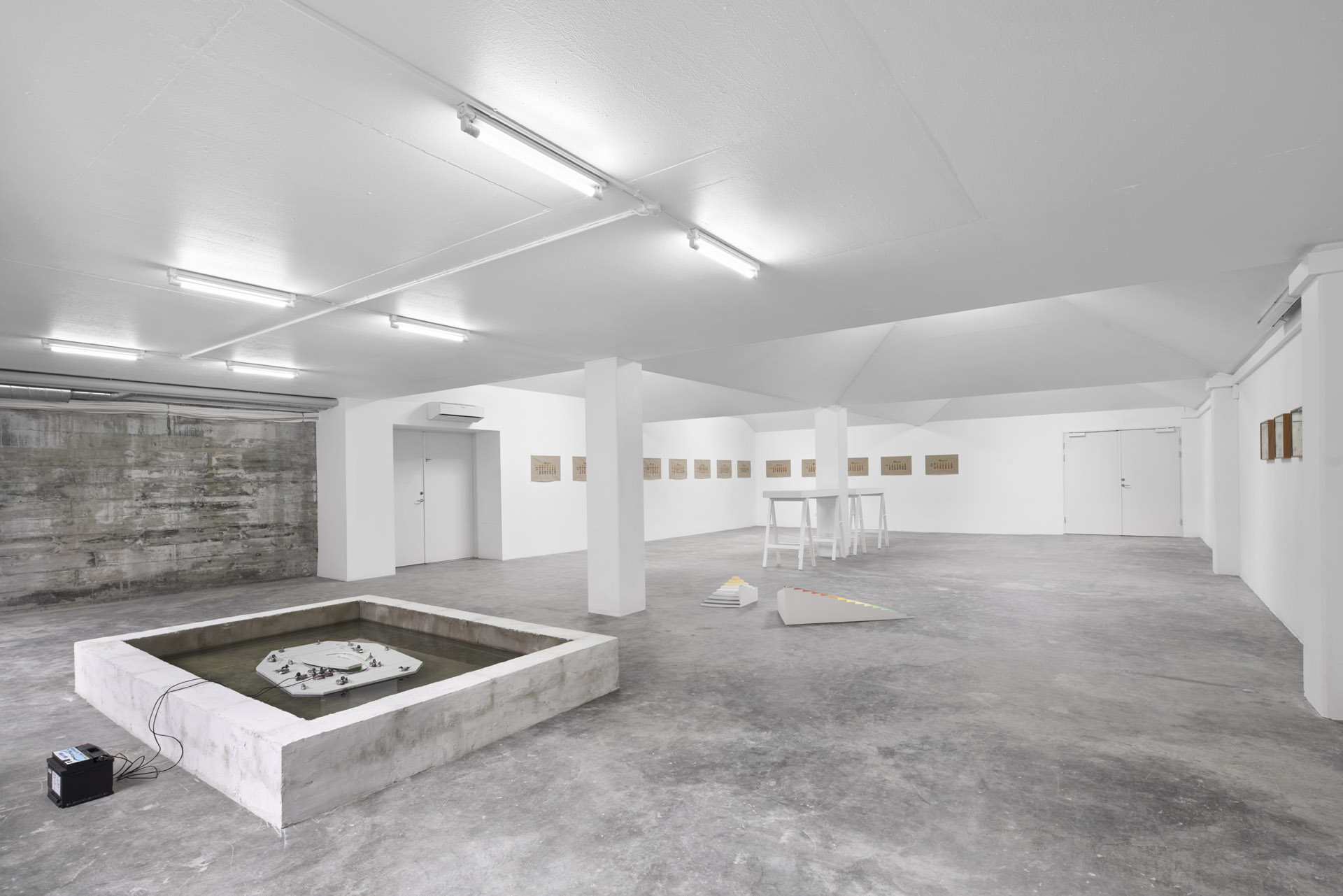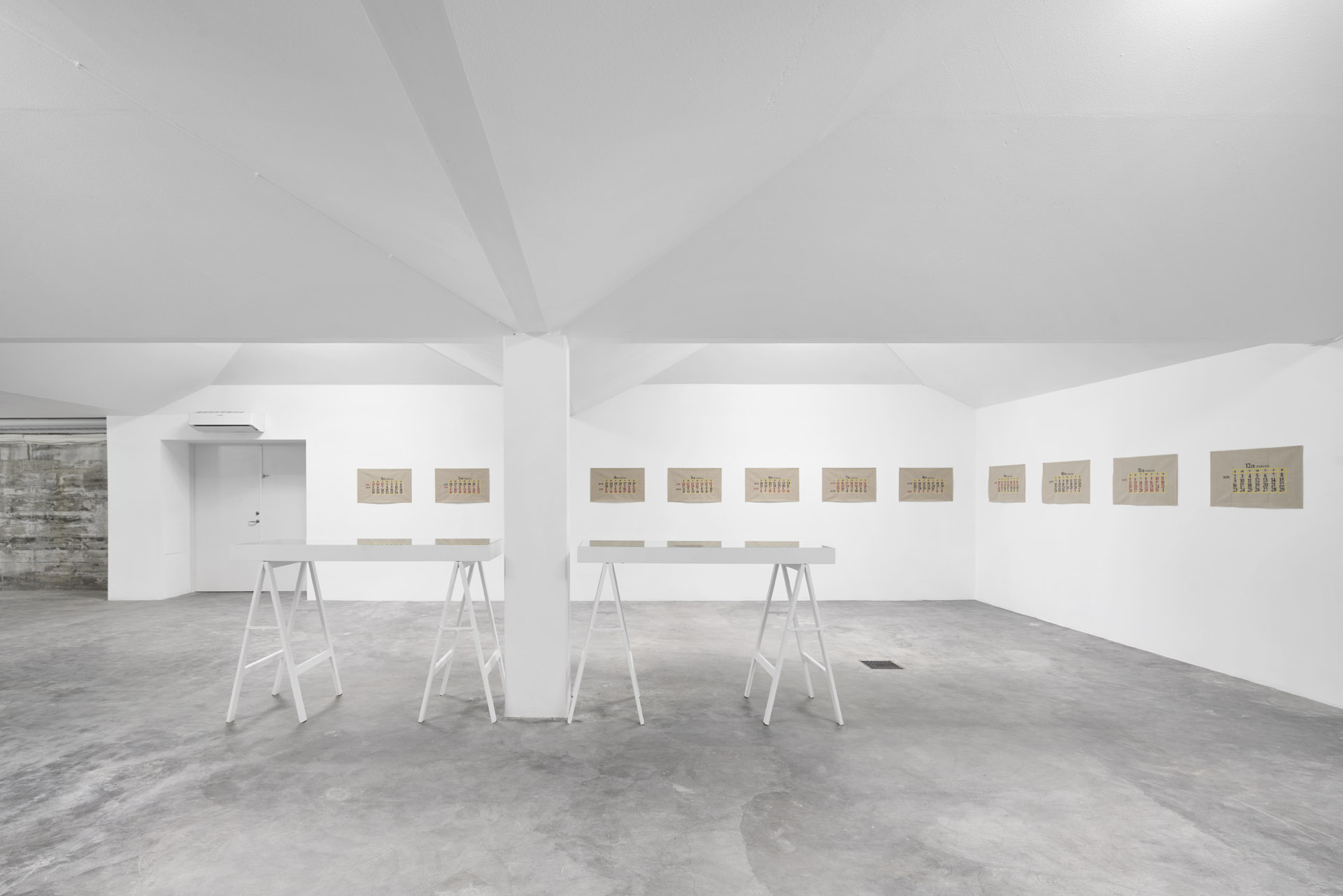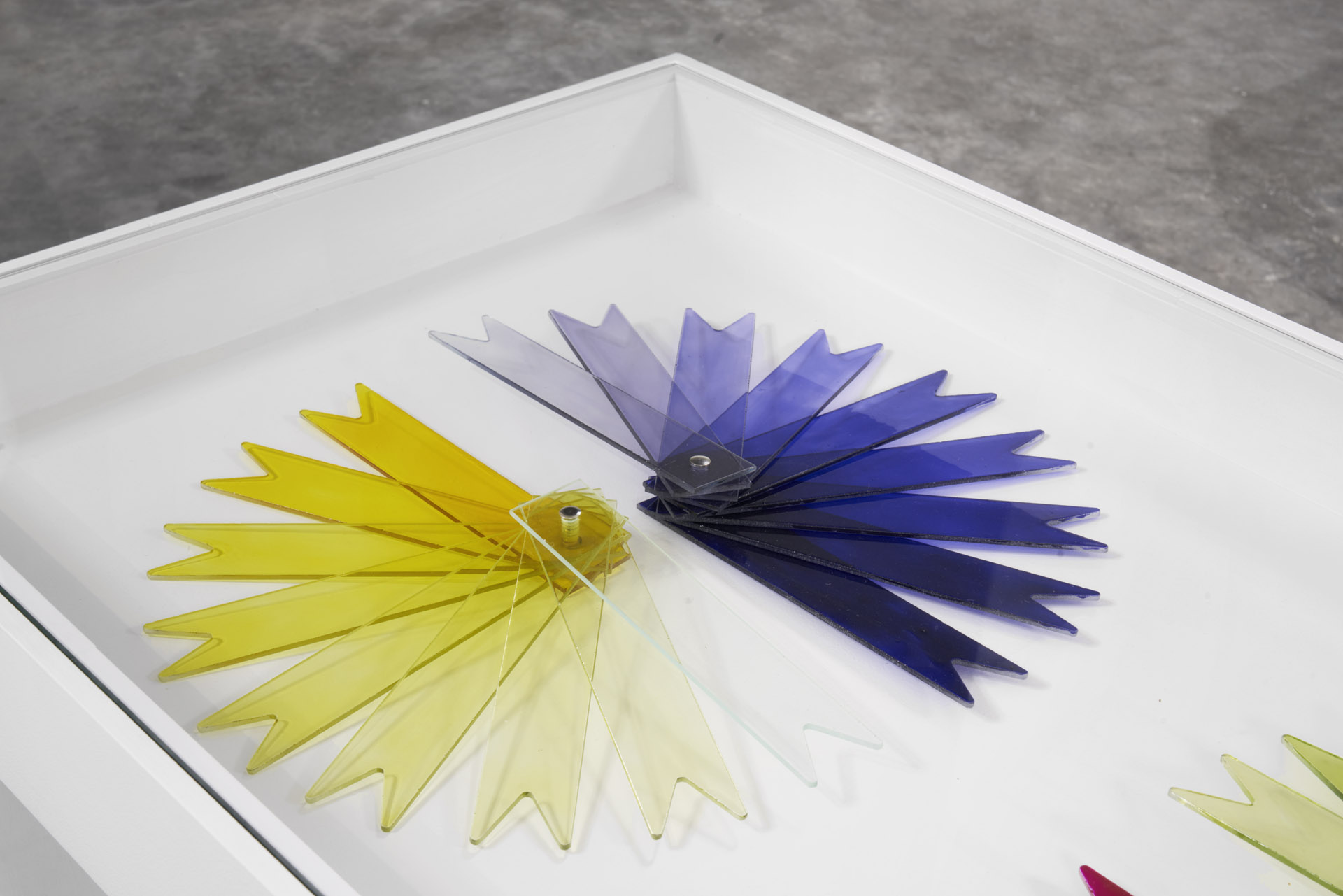Artist: Marina Pinsky
Exhibition title: Undertow
Venue: Simian, Copenhagen, Denmark
Date: August 28 – October 16, 2021
Photography: GRAYSC / All images copyright and courtesy of the artist and Simian, Copenhagen
Note: Exhibition booklet is available here
In the exhibition Undertow, artist Marina Pinsky extracts and shapes content from calendars, charts, cartographical diagrams and other utilitarian schemes for measuring and altering space, time and everything in between. Inspired by Simian’s specific location in Ørestad, under a man-made pond in this newly- built district which was formerly a nature preserve, Pinsky chose to focus on the theme of water as a construction and unifying subject of the works on view. These works act as signposts, pointing to the absurdity of ordering life in relation to the logic of industry.
Color as poison or a sign of contamination is explored throughout a number of works, including a series of hand-painted sculptural objects. These are based on various color charts used for measuring water impurities, in the field— Plein Air (Forel-Ule-Scale Fan), the home— Plein Air (Cyanide Comparator Fan) and the body—in this case one regimented by the food industry—Plein Air (Salmofan).
The Forel-Ule scale is a color gradient for monitoring the quality of natural waters, used alongside the Secchi Disk at precise water depths. The original scale is made up of precisely dyed liquids in small glass vials, which the observer uses as a comparison chart to the waterway being studied. Until recently, this scale was used only by specialists in the field. In the last several years, however, multiple scientists and educators have released scientific papers detailing how “citizen scientists” can make their own water measurement devices with more accessible materials such as photographic gels and 3D printed plans. In Plein Air (Forel-Ule Scale Fan) Pinsky interprets the colors of the glass vials and the photographic filters into a third scale by painting the translucent color scale on fan blades made of glass.
Pinsky expands this procedure of individual color perception to other chemical test kits for specific chemical impurities in water. Gradations of each color indicate the parts per million of the detected chemical. These comparator glass vials are filled with photosensitive chemicals. Pinsky translates their color densities to paintings on water-jet cut glass.
In Plein Air (SalmoFan) Pinsky paints the color range used by the aquaculture industry to dye farmed salmon flesh to match consumer preferences. Wild salmon turns pink from eating krill and shrimp. Farmed salmon is on a fishmeal diet and its meat is grey without additives. In addition to contaminating riverbeds and oceans, the omnipresent dyes are contested as high levels may cause retinal damage in humans.
The deliberation on pharmacological industries stem from the time Pinsky spent in Switzerland, in preparation for her exhibition at Kunsthalle Basel in 2016. During this time, the artist engaged with the city’s main local industry— pharmaceuticals. She visited a number of these powerhouses, their campuses, archives and museums. She learned that several big pharma companies had their origins in the 19th century as dye producers. A historical/chemical through-line began to emerge between medicine, agri- business and photographic technology. The exhibition’s title was Dyed Channel, based on the 1986 Sandoz chemical disaster which colored the Rhine red.
At the Natural History Museum in Basel, Pinsky photographed stuffed specimens of fish in a room dedicated to life in the Swiss waterways. Later, equipped with an underwater camera, she dived into the river Rhine in the city’s center, observing the underwater landscapes and inhabitants, from fish to urban litter. Rhine Riverbed is a series of photographs of these submerged scenes framed behind glass printed with Swiss fish images, collapsing the experienced and the archived, the present and the imagined pre- industrial waters.
The landscape reduced to its most basic signifiers is explored in the sculpture pair Adaptiv-perspektive Farbenplastik and Spektral-adaptive Farbenplastik. The sculptures are based on a 1910 diagram by cartographer Karl Peucker. This map legend introduces color codes at various elevations, corresponding to specific terrain. In the sculptural incarnation, Pinsky builds up the three-dimensional territory in reverse, which points out the omission of “in between” steps and slopes.
In Decoy (2014) the sociological reliance on the knowable, the surveyable, and the reproducible is put in relief. The sculpture is a scale model of a boat floating in a shallow pool of water. This boat is modeled after a duck hunting boat Pinsky saw at the Decoy Museum in Havre de Grace, Maryland, on the Chesapeake Bay. In her model, the position of the shooter is occupied by a cell-phone signal jammer. This device works on cellular frequencies following the same decoy strategy–sending out junk signals to confuse the receiver. Additionally, its power source—a car battery—is sitting next to the tank. The flock behavior in ducks and humans is infiltrated by the addition of birds and the deduction of cellular reception—adding and deducting being the primary abstracting techniques for bundling up information in a handful of exemplary colors and forms.
Systems of classifications and identification are collectively upheld. And as such, they are challenged with various degrees of conviction and success. Pinsky locates these social relations, and makes them un-naturalized. Her 13 Month Calendar is a series of digital embroideries of Kodak’s internal calendar, converted from the year 1930 to the International Fixed Calendar. This system divided the 365 days of the year into thirteen months of exactly four weeks, with the additional month of “Sol” added in the middle of the year. George Eastman, Kodak’s founder, was a fervent supporter of The International Fixed Calendar League, lobbying other early 20th century industrialists to adopt the system. Meanwhile, the IFCL called sessions of the US Congress and League of Nations to officially implement its use, without success. The offices and factories of Kodak operated internally within this particular understanding of time until in 1989, when the calendar was quietly retired.
The works in Undertow are meant to sweep the viewer into a swirling undercurrent of histories, in the guise of objects appearing placid on the surface. The regimented steps taken in each work conjure up the impulse to individuate nature in Aftenstjernen, a painting by Norwegian painter Bendik Riis, of a waterfront, foregrounded by a perimeter of trees, with branches that not once overlap. Aftenstjernen, regardless of Riis’s psychological states, belongs to the tradition of landscape painting as a way of understanding nature. Pinsky’s Undertow pictures the impossibility thereof. The exhibition points out that in case it becomes necessary, equipped with our Forel-Ule scale, maps of disappeared territories, and all the human and computational knowledge available, it is unlikely that we could reverse engineer the world, its waters, fish, lands and elevations squeezed into multifarious, nonetheless countable, color blocks.
Text by Shirin Sabahi
Marina Pinsky, born 1986 in Moscow, graduated from University of California Los Angeles in 2012. She has exhibited at the 1st Riga Biennale (2018), the 13th Lyon Biennale (2015), WIELS in Brussels (2015, 2017), De Vleeshal in Middelburg (2017), MOMA in New York (2015) and Hammer Museum in Los Angeles (2014). In 2016 she presented the large solo exhibition entitled Dyed Channel at Kunsthalle Basel. Pinsky is represented by 303 Gallery in New York City and CLEARING in New York/Brussels. She lives and works in Brussels and Berlin.
Marina Pinsky, Undertow, 2021, exhibition view, Simian, Copenhagen
Marina Pinsky, Undertow, 2021, exhibition view, Simian, Copenhagen
Marina Pinsky, Undertow, 2021, exhibition view, Simian, Copenhagen
Marina Pinsky, Undertow, 2021, exhibition view, Simian, Copenhagen
Marina Pinsky, Decoy, 2014, 122 x 183 x 30.5 cm, glass, wood, paint, electronics, car battery, Leca blocks, concrete, water, drain
Marina Pinsky, Decoy, 2014, 122 x 183 x 30.5 cm, glass, wood, paint, electronics, car battery, Leca blocks, concrete, water, drain
Marina Pinsky, Undertow, 2021, exhibition view, Simian, Copenhagen
Marina Pinsky, Adaptiv-perspektive Farbenplastik, 2021, 120 x 87 x 33 cm, multiplex, wood glue, nails, filler, acrylic paint; Spektral-adaptive Farbenplastik, 2021, 72 x 39 x 20.5 cm, MDF, wood glue, nails, filler, acrylic paint
Marina Pinsky, Undertow, 2021, exhibition view, Simian, Copenhagen
Marina Pinsky, Undertow, 2021, exhibition view, Simian, Copenhagen
Marina Pinsky, Rhine Riverbed 33, 2015, 33.8 x 44.4 cm, archival inkjet print, UV cured inkjet print on glass
Marina Pinsky, Rhine Riverbed 11, 2015, 33.8 x 44.4 cm, archival inkjet print, UV cured inkjet print on glass
Marina Pinsky, Rhine Riverbed 25, 2015, 33.8 x 44.4 cm, archival inkjet print, UV cured inkjet print on glass
Marina Pinsky, Rhine Riverbed 10, 2015, 33.8 x 44.4 cm, archival inkjet print, UV cured inkjet print on glass
Marina Pinsky, Rhine Riverbed 32, 2015, 33.8 x 44.4 cm, archival inkjet print, UV cured inkjet print on glass
Marina Pinsky, Rhine Riverbed 24, 2015, 33.8 x 44.4 cm, archival inkjet print, UV cured inkjet print on glass
Marina Pinsky, Rhine Riverbed 36, 2015, 33.8 x 44.4 cm, archival inkjet print, UV cured inkjet print on glass
Marina Pinsky, Rhine Riverbed 11, 2015, 33.8 x 44.4 cm, archival inkjet print, UV cured inkjet print on glass
Marina Pinsky, Undertow, 2021, exhibition view, Simian, Copenhagen
Marina Pinsky, 1930 Kodak Calendar 13 parts (1, 2), 2020, 71 x 44.5 cm, digital embroidery on Belgian Linen
Marina Pinsky, 1930 Kodak Calendar 13 parts (13), 2020, 71 x 44.5 cm, digital embroidery on Belgian Linen
Marina Pinsky, Undertow, 2021, exhibition view, Simian, Copenhagen
Marina Pinsky, Undertow, 2021, exhibition view, Simian, Copenhagen
Marina Pinsky, Plein Air (Cyanide Comparator Fan), 2021 (deep blue), 39 x 22 x 3.5 cm, waterjet-cut glass, glass paint, steel attachment
Marina Pinsky, Plein Air (Cyanide Comparator Fan), 2021 (deep blue), 39 x 22 x 3.5 cm, waterjet-cut glass, glass paint, steel attachment, Plein Air (Molybdate Comparator Fan), 2021 (yellow), 39 x 22 x 3.5 cm, waterjet-cut glass, glass paint, steel attachment, Plein Air (Zelyonka Comparator Fan), 2021 (green), 39 x 22 x 3.5 cm, waterjet-cut glass, glass paint, steel attachment, Plein Air (Bromine Comparator Fan), 2021 (magenta), 39 x 22 x 3.5 cm, waterjet-cut glass, glass paint, steel attachment, Plein Air (Phenols Comparator Fan), 2021 (red), 39 x 22 x 3.5 cm, waterjet-cut glass, glass paint, steel attachment, Plein Air (Sulfide Comparator Fan), 2021 (cyan), 39 x 22 x 3.5 cm, waterjet-cut glass, glass paint, steel attachment
Marina Pinsky, Plein Air (Cyanide Comparator Fan), 2021 (deep blue), 39 x 22 x 3.5 cm, waterjet-cut glass, glass paint, steel attachment, Plein Air (Molybdate Comparator Fan), 2021 (yellow), 39 x 22 x 3.5 cm, waterjet-cut glass, glass paint, steel attachment
Marina Pinsky, Undertow, 2021, exhibition view, Simian, Copenhagen
Marina Pinsky, Every Month – 4 Weeks, 2020, 88 x 70 cm, digital embroidery on Belgian Linen




























